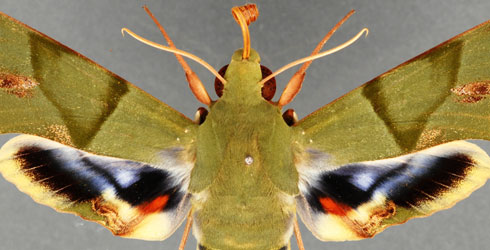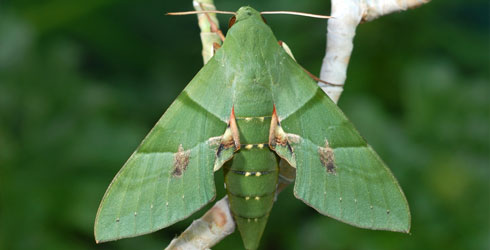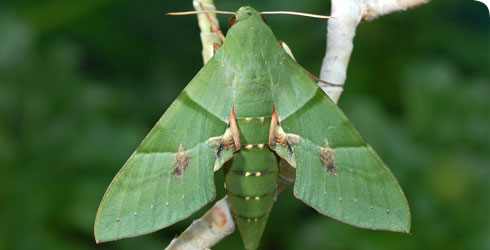Eumorpha labruscae
Eumorpha labruscae, is an exotic hawkmoth that can grow to the size of your hand. This migrating moth is commonly found in South and Central America, and occasionally as far north as Canada. It is known as the gaudy sphinx thanks to its remarkable markings and the amazing array of colours on its wings. Discover how its colourful larvae mimic a snake to avoid predation, and how the adult moth seeks out a mate.
Eumorpha labruscae, the gaudy sphinx, is a Neotropical hawkmoth with a relatively large geographical distribution.
It has a combination of green, blue, red and yellow colouration on the wings which gives it an exotic and impressive appearance and also explains its flamboyant common name.
The moth’s Latin name is composed of the Greek word Eumorpha which means well-formed, and labruscae the Latin word for fox grape (Vitis labruscae) - one of the plants on which the larva feeds.
Species detail
-

Taxonomy
Eumorpha labruscae can have a wingspan of up to 12cm. Take a closer look at the detailed markings of this beautiful moth.
-

Distribution
The gaudy sphinx is found from the southern states of the USA, throughout the West Indies and Central and South America. It also migrates and has been found a far north as Canada. Find out where else you might spot this migrant moth.
-

Biology
In the south of its range this moth produces several generations per year. It lays its eggs on the leaves of host plants where the larvae feast once hatched. Discover how the larva changes colour and shape as it develops and moults.
-

Behaviour
This remarkable moth uses its antennae to seek out a mate, and in its larval stage can mimic a snake to avoid being eaten. It even emits a high-pitched squeak when agitated. Find out more about this fascinating species.
-
References
Get reference material for Eumorpha labruscae.
Images

This adult individual of Eumorpha labruscae from the Natural History Museum collection shows how the blue-green coloration of the live moth fades to yellow-green after death.
© Alessandro Giusti
Eumorpha labruscae. The grown up caterpillar shows eye spots on each sides of the swollen third thoracic segment. When agitated the larva retracts the head and the first two thoracic segments into the third one and the snake deception is complete.
© Alessandro Giusti
This adult individual of Eumorpha labruscae, photographed in Costa Rica shows the beautiful deep blue-green colouration.
© Jean HaxaireAbout the author
A word from the author
"Eumorpha labruscae has been recorded from Paraguay but its presence in the Paraguayan Chaco is not confirmed.
"Thanks to Ian Kitching for commenting on the draft."

